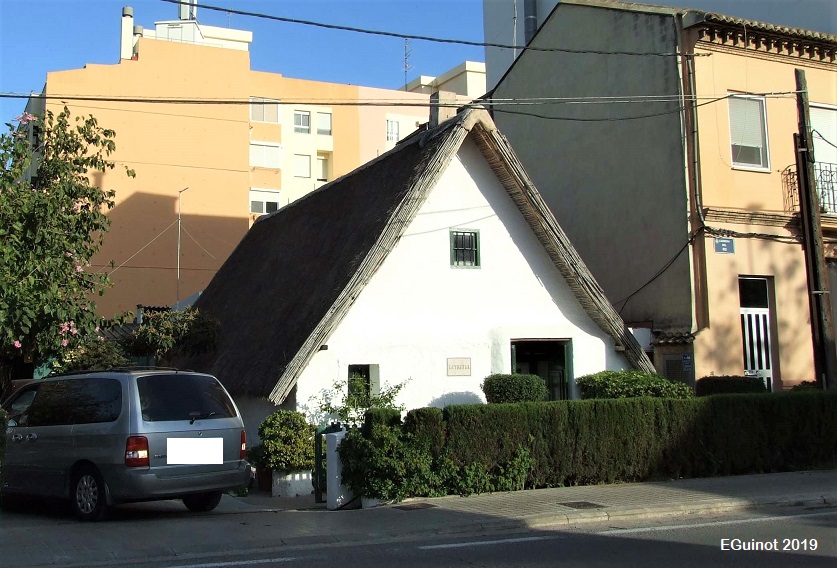
It is located on the former Pinedo and El Saler road no. 249, now in the consolidated urban centre of this village.
Late 19th century - early 20th century.
According to the 2018 Territorial Action Plan for l’Horta (the irrigated land) of València, the barraca (hut) 'La Genuina' in Pinedo dates from the beginning of the 20th century, although J.A. Garcia Esparza in his Catalogue of alqueries (farmhouses) in l’Horta attributes to it some 250 years of age. In fact, and as in the case of many other popular constructions in l’Horta of València, it is not at all easy to give an individual chronology and history of its own. Due to its simple constructive structure, it can usually be dated back to the second half of the 19th century or the beginning of the 20th century, even with possible important modifications at some point due to necessary reconstruction. These barraques (huts) do not usually appear in the documents of previous centuries in an identifiable form by names or place names, while at an oral level they were usually known in their surroundings by the name or nickname of the people who owned or lived there. For this reason, the name of the barraca (hut) may have been modified due to the change of residence of the people who owned or lived there.
According to the Catalogue of Protected Assets and Spaces of Urban Nature of the Simplified Revision of the General Urban Development Plan of València (2013), this hut was part of the old farmhouse that defined the nucleus of this village. It is a barraca (hut) that has remained over time, despite having suffered several fires and changes of use. The main elements of its architectural features have been preserved, such as the doors, the windows and especially the traditional roof made of cane and reed. Its dimensions are also the usual ones: 6,73 m (22ft 0.9 in) of main façade and 11,75 m (38ft 6.5 in) deep, with a floor plan of 79 m2 (850.3489ft²), as explained by J. A. Garcia Esparza in his Catàleg d’alqueries de l’Horta (Catalogue of farmsteads in the irrigated land of València). The walls of the base are made of compost and the foundations are made of masonry.
Actualment allotja un restaurant.
- Revisió Simplificada Del Pla General De València - Catàleg de béns i espais protegits de Naturalesa Rural (2013) - EPA_SU_19.03.
- Pla d’Acció Territorial de l’Horta de València. Catàleg de béns i espais protegits de l’Horta de València (2018) - EPA_20.02.
- Direcció General de Patrimoni Cultural Valencià. Catàleg de patrimoni.
- Notícia de València Bonita (?) - La Genuina: una preciosa barraca valenciana convertida en un restaurante de cocina valenciana.
- Notícia de Las Provincias (11 d’octubre de 2011) - 'La Genuina' cerrará la histórica barraca al declarar ilegal la terraza el Ayuntamiento.
- Notícia de Levante-EMV (26 de setembre de 2014) - La Genuina... o cómo comer en una auténtica barraca valenciana.
GARCIA ESPARZA, J. A. (2012), Barracas del litoral Mediterráneo: catálogo de Valencia y su entorno, Castelló, Universitat Jaume I, pp. 166-167.
DEL REY. M. (2010), Arquitectura Rural Valenciana, Barcelona, Galerada (1ª edició: València, Direcció General de Patrimoni Artístic, 1996)
GARCIA ESPARZA, J. A. (2008), “La barraca Valenciana, procesos de transformación”, Revista valenciana d'etnologia, 3, pp. 145-159.
CRUZ OROZCO, J. (2003), “Las viviendas de cubierta vegetal en el territorio valenciano: el caso de la barraca”, Revista El Pajar: Cuaderno de Etnografía Canaria, 14, pp. 111-116.
RUIZ RUBIO, J. V. (1999), Construint una barraca valenciana, València, Ajuntament d’Alboraia-Col·legi d’Aparelladors i Arquitectes Tècnics de València-Col·legi d’Arquitectes de la Comunitat Valenciana.
SANCHIS GUARNER, M. (1957), Les barraques valencianes, Barcelona, Ed. Barcino. (reedició: València, Institució Alfons el Magnànim, 1999).
ALMELA VIVES, F. (1960), La vivienda rural valenciana, Valencia, La Semana Gráfica.
CASAS TORRES, J. M. (1944), La vivienda y los núcleos rurales de la huerta de Valencia, València, Diputació Provincial de València.
Photos: E. Guinot















